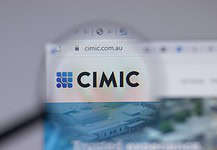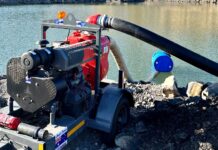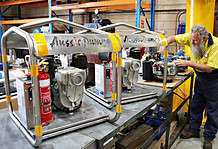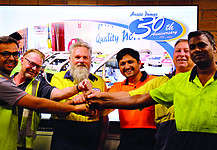Most light vehicles found on a mine site are used in applications that are far more demanding than that of the typical 4WD enthusiast. As such, they require upgraded suspension systems to enable them to legally and safely carry heavier loads than their regular street variants can handle.
Due to the need to comply not only with the transport codes of each individual state and territory but also the requirements of Australia’s largest mining companies, upgrading the Gross Vehicle Mass (GVM) of any 4WD is a complex matter. All componentry fitted to these vehicles, from springs to shock absorbers, bushes and link arms must be built to OEM or better standards and must also be engineered and exhaustively tested to function flawlessly under higher load conditions than the stock components.
The testing includes an assessment of the vehicle’s body roll at both unloaded and fully loaded ride heights, its ability to brake within a given distance and repeat that braking performance without fade and numerous other factors. Naturally, building a complete system that can achieve all these goals requires specialised engineering, a great deal of experience and high-quality manufacturing processes. Such capabilities are beyond most suspension fitting workshops and lie, instead, in the realm of Second Stage Manufacturers (SSMs).
Design and Manufacture
Now in its 90th year of business as a manufacturer and supplier of suspension components to suit a broad range of applications for the automotive, agriculture, mining and railway industries, Lovells Automotive Systems has cemented its reputation as a manufacturer and supplier of premium quality springs and suspension.
One of the SSM services Lovells offers is the upgrade of the load-bearing capacity and axle capacities of certain makes and models of new vehicles (prior to first registration). As Lovells’ General Manager, Mike Davison, explains – this adjustment is required because the Original Equipment Manufacturers (OEM) often build new vehicles to “cover a massive demographic at the most cost-effective price. Accordingly, the capabilities specified by the OEM are nowhere near what is required by most owners to safely operate the vehicle and to ensure the vehicle is fit for purpose,” he said.
“SSMs carry out modifications to these vehicles by using products that they produce to upgrade the vehicle’s maximum laden mass, which is otherwise known as ‘gross vehicle mass’ or GVM.”
Mr Davison said the company had 19 years’ experience in second stage manufacturing and is able to upgrade most popular light 4WDs up to 4.5t.
“We also always keep abreast of legislation to ensure modifications are in line with the Australian Design Rules, Vehicle Standards Bulletins, Federal code of practice as well as regulations in each state and territory,” he said. Adding that current legislation between State jurisdictions covering modified vehicles was a minefield, and Lovells ensure that all regulations are adhered to, with no liability on Lovells’ part when it comes to overloading SSM vehicles.
GVM Upgrades
GVM upgrades are designed and tested to ensure:
- the ongoing compliance and safety of vehicles and occupants
- the integrity of the vehicle drive train, driveline, chassis and components
- the continuing safety of other road users, when the vehicles are carrying/towing heavy loads, beyond what the OEM specifies.
“SSMs provide these services to allow the eventual owner of the new vehicle in question to meet the practical and documentary compliance requirements of work safety, police licencing, insurance, lessors and fleet managers,” he said.
Some of the vehicle applications that require GVM upgrades include:
- emergency service vehicles: police; ambulance and fire services
- mine sites and in the power and gas industry
- national park rangers
- border protection
- caravanning industry
- television news industry.
By upgrading their vehicles with these engineered and tested upgrades, owners can potentially protect themselves against:
- claims from breaches of OH&S rules
- claims against employee negligence
- the possibility of insurance companies avoiding payouts
- litigation if vehicle is operated beyond the legal load
SSMs take full responsibility for all modifications and upgrades they perform on new vehicles as part of a GVM upgrade, including responsibility for compliance with the Australian Design Rules (ADRs).
“When an SSM performs GVM upgrades, they issue the new owner with a copy of its owner’s manual and overview documents relating to the upgrade, its revised capacities and warranty terms, which are borne by the SSM,” Mr Davison said.
Case study
TOYOTA PRADO 150 Series
Lovells kits are the perfect solution for owners of Toyota 150 Series Prados, who have a need to carry loads to a GVM of 3500kg (up from 3000kg), while at the same time meeting the practical and documentary compliance requirements of work safety, police licensing, insurance, lessors and fleet managers. The Lovells GVM upgrade kit can be fitted to vehicles with or without Toyota’s KDSS (Kinetic Dynamic Suspension System). Lovells’ GVM upgrade kits have also been tested and approved for Full Volume Second Stage Manufacture to comply with ADR35/05 ESC (Electronic Stability Control) Sine with Dwell verification.
The Lovells GVM upgrade kit is approved by the Department of Infrastructure, Transport, Regional Development and Local Government and the following components:
- 2 x Lovells heavy duty front coil springs
- 2 x Lovells heavy duty rear coil springs
- 4 x Lovells Gas Legend 40mm twin tube, long travel gas shock absorbers
- 1 x Federal Compliance plate with revised GVM (pre-registration vehicles)
OR 1 x State Compliance GVM upgrade modification plate (registered vehicles)
- 1 x tyre loading placard (decal) with revised axle capacities
- 1 x GVM Upgrade owner’s manual
- 1 x fitting instruction manual
- 1 x KDSS valve adjustment warning decal
Do’s and don’t’s
Because the kits are approved on the basis of Lovells Springs being an SSM, the responsibility ultimately lies with Lovells; so therefore only Lovells Automotive Systems’ authorised fitters (Production Facilities) are approved to fit the kits. On completion of the kit being fitted by the authorised fitter, a Federal or State compliance checklist must be filled out and retained by the fitter and Lovells for future reference.
Federal Compliance: New vehicles must be fitted prior to first registration. They are simply then registered with a revised GVM as per the new compliance plate. Vehicles which are already registered cannot be fitted with a kit under this Federal Approval.
State Compliance: GVM Upgrades can be fitted to already registered vehicles in all States and Territories under the individual State regulatory modification scheme and, after modification, will have to be inspected by a Lovells endorsed State engineering signatory. Extra cost for inspection and documents will be incurred.
Pre-registration GCM upgrades
The Gross Combined Mass (GCM) is not noted on Lovell’s SSM Road Vehicle Descriptor (RVD), nor is GCM noted on the OEM’s RVD. A GCM figure is also not noted on any OE or SSM Federal Compliance plates, however the figure is usually gazetted or published in handbooks, owner’s manuals, sales brochures or specification sheets. Lovells’ RVD for each SSM Identification Plate Approval notes the new GVM capacity and the maximum braked towing capacity.
But as a responsible SSM, Lovells also publishes the corresponding new GCM capacity for the vehicle, to reflect the change in capacity as a result of the upgrade. Lovells believes this is important for numerous reasons, including for accuracy and safety.? An updated GCM may be specified by a manufacturer and Lovell’s believes it is good practice for manufacturers to do so.
Post-registration upgrades
When a manufacturer modifies a vehicle that has already been registered, this modification is governed by the various State and Territory authorities and their individual type approvals or modification codes. Whether a particular type of modification is available post-registration, therefore depends on the position of the State or Territory in question. NSW, SA and VIC recognise a revised GCM specified by an SSM if endorsed by the inspecting engineering signatory, who must be an endorsed engineer who has access to evidence packages. Tasmania recognises a revised GCM specified by an SSM. QLD no longer recognises a revised GCM above the GCM nominated by the OEM, although the Government is exploring options for the issue of a new code that deals with GCM increases.
WA, ACT and NT no longer recognise a revised GCM above the GCM nominated by the OEM if the vehicle is modified after first registration.
Accuracy
Mr Davison said not every SSM can or does nominate a revised GCM. “Lovells does nominate revised GCM capacity figures as a SSM,” he said. “Lovells is committed to going above and beyond and I believe we are the only SSM that has a full complement of test data and evidence packages to satisfy the December 2019 released GCM and Towing Upgrade Technical Working Group test regime.”
This comprehensive new test regime was commissioned by the AAAA, exceeds OEM requirements and includes many stringent tests.
Warranty
As an SSM approval holder, Lovells takes full responsibility for the changes the revised GVM, GCM and the Rated Towing Capacity may have on the duty cycle of the vehicle systems and sub-systems (for example brakes, engine, automatic transmission, axles assemblies, tow coupling, etc) and any follow on-effect on warranty claims by vehicle owners.
“Vehicle warranty is not affected when a GVM or Brake Towing Capacity (BTC) upgrade is fitted,” Mr Davison said.
“Our testing and analysis procedures are stringent and undertaken by accredited automotive engineering consultants to ensure OEM components are not compromised. Modifications and load limits are within theoretical service/safety factors to ensure the integrity and longevity of OE parts associated with increasing the vehicle’s load carrying capabilities.
“As Lovells is an SSM, it is our responsibility to document these tests and thus take responsibility for the GVM, GCM and BTC upgrades and their compliance. Therefore, should an OEM component fail and be directly attributed/caused by the vehicle carrying loads to a maximum GVM, GCM and BTC, or part failure associated with the GVM, GCM and BTC upgrade modification, Lovells will take full responsibility to cover warranty of any failed component after written proof and testing by an independent body has been lodged and confirmed the failure is due to the vehicles increased GVM, GCM and BTC.”
Warranty excludes any component or system which has been identified by the OEM as having a potential failure or problem.
More information:|
Lovells Automotive Systems
02 9820 6800
0421 709 727
[email protected]
www.lovells.com.au










































